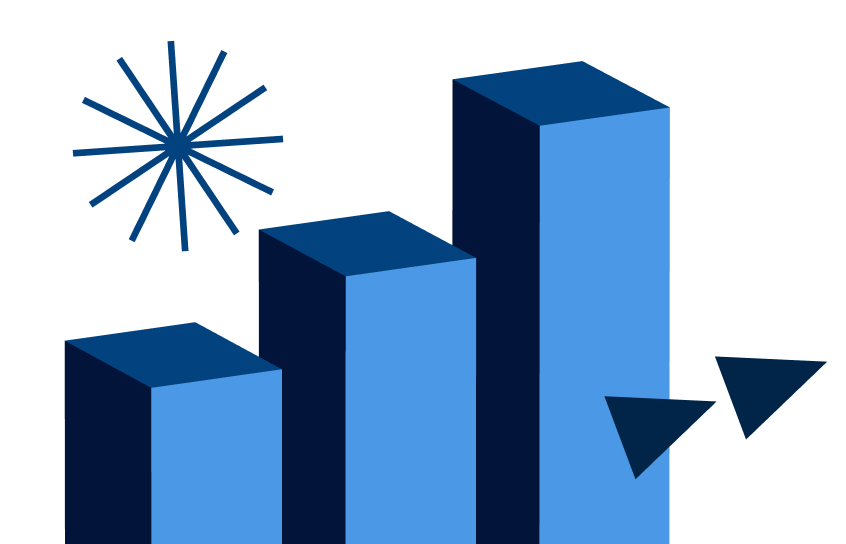Best Index Funds for April 2025 and How to Invest
Index funds are a low-cost, easy way to build wealth. Here's everything you need to know to get started investing.

Many, or all, of the products featured on this page are from our advertising partners who compensate us when you take certain actions on our website or click to take an action on their website. However, this does not influence our evaluations. Our opinions are our own. Here is a list of our partners and here's how we make money.
The investing information provided on this page is for educational purposes only. NerdWallet, Inc. does not offer advisory or brokerage services, nor does it recommend or advise investors to buy or sell particular stocks, securities or other investments.
What are index funds?
An index fund is a group of stocks (or other investments) that aims to mirror the performance of an existing market index, such as the S&P 500 index. An index is made up of companies or securities that represent a part of the financial market. Some large indexes offer a look into the health of the economy as a whole.
How to invest in index funds
Investing in index funds is easy. Here's a quick rundown of how to do it:
1. Set a goal for your investments
Before you start investing in index funds, it's important to know what you want your money to do for you. If you're looking for a short-term place to park your money and earn a bit of interest, you may be more interested in certificates of deposit, savings accounts or money market funds.
But if you're looking to let your money grow slowly over time, particularly if you're saving for retirement, index funds may be a great investment for your portfolio.
2. Do your research
Once you know what index you want to track, it's time to look at the actual index funds you'll be investing in. When you're investigating an index fund, it's important to consider several factors:
Company size and capitalization. Index funds can track small, medium-sized or large companies. (These funds are also known as small-, mid- or large-cap indexes).
Geography. There are funds that focus on stocks that trade on foreign exchanges or a combination of international exchanges.
Business sector or industry. You can explore funds that focus on consumer goods, technology and health-related businesses.
Asset type. There are funds that track bonds, commodities and cash.
Market opportunities. These funds examine emerging markets or other growing sectors for investment.
Nerdy Tip: Despite the array of choices, you may find that one fund is enough. Investing legend Warren Buffett has said that the average investor need only invest in a broad stock market index to be properly diversified. However, you can easily customize your fund mix if you want additional exposure to specific markets in your portfolio. (That might mean more emerging market exposure, a higher share in small companies or exposure to bonds, for example.
3. Pick your funds and examine costs
At this point, it's time to choose which corresponding index fund to buy. This often boils down to cost.
While low costs are one of the biggest selling points of index funds, don’t assume that all index mutual funds are cheap. They still carry administrative costs, which are subtracted from each fund shareholder’s returns as a percentage of their overall investment.
Two funds may have the same investment goal — like tracking the S&P 500 — yet have management costs that can vary wildly. Those fractions of a percentage point may seem like no big deal, but your long-term investment returns can take a hit from the smallest fee inflation. Typically, the bigger the fund, the lower the fees.
Here are the important areas to dig into:
Investment minimum. The minimum required to invest in a mutual fund can run as low as nothing or as high as a few thousand dollars. Once you’ve crossed that threshold, most funds allow investors to add money in smaller amounts.
Expense ratio. This is one of the main costs of an index fund. Expense ratios are fees that are subtracted from each fund shareholder’s returns as a percentage of their overall investment. You can find the expense ratio in the mutual fund’s prospectus or when you look up a quote for a mutual fund on a financial site.
» Dive deeper: View our list of low-cost index funds
NerdWallet rating 5.0 /5 | NerdWallet rating 4.4 /5 | NerdWallet rating 4.3 /5 |
Fees $0 per trade for online U.S. stocks and ETFs | Fees $0 per trade | Fees $0 per trade. Other fees apply. |
Account minimum $0 | Account minimum $0 | Account minimum $0 |
Promotion None no promotion available at this time | Promotion Get up to $600 when you invest in a new Merrill account | Promotion Get up to $1,000 when you open and fund an E*TRADE brokerage account. Terms apply. |
4. Decide where to buy them and place your order
You can purchase an index fund directly from a mutual fund company or a brokerage. When you're choosing where to buy an index fund, consider:
Fund selection. Do you want to purchase index funds from various fund families? The big mutual fund companies carry some of their competitors’ funds. However, the selection may be more limited than what’s available in a discount broker’s lineup.
Convenience. You may want to find a single provider who can accommodate all your needs. For example, if you’re just going to invest in mutual funds (or even a mix of funds and stocks), a mutual fund company may be able to serve as your investment hub. But if you require sophisticated stock research and screening tools, a discount broker that also sells the index funds you want may be better. (If you don't have a brokerage account, here's how to open one.)
Trading costs. If the commission or transaction fee isn’t waived, consider how much a broker or fund company charges to buy or sell the index fund. Mutual fund commissions are higher than stock trading ones, about $20 or more. Compare that with less than $10 a trade for stocks and ETFs.
Tax-cost ratio. In addition to paying fees, owning the fund may trigger capital gains taxes if held outside tax-advantaged accounts, such as a 401(k) or an IRA. Like the expense ratio, these taxes can take a bite out of investment returns.
Impact investing. Want your investment to make a difference outside your portfolio? Some funds target companies with a focus on environmental or social justice causes. (Learn more about impact investing.)
Commission-free options. Do they offer no-transaction-fee funds? This is an important metric we use to rate discount brokers.
When you go to purchase the fund, you may be able to select a fixed dollar amount to spend or choose a number of shares. The share price of the index fund and your investing budget will likely determine how much you're willing to spend. For instance, if you have $1,000 you'd like to invest in an index fund and the fund you're looking at is selling for $100 a share, you'd be able to purchase 10 shares.
» Need help? Here's how to open a brokerage account
5. Keep an eye on your investments
Index funds have become one of the most popular ways for Americans to invest because of their ease of use. Their diversity — and returns that typically beat actively managed accounts — don't hurt, either. But passive management doesn't mean you should completely ignore your index fund. Here are some things to think about over time:
Is the index fund doing its job? Your index fund should mirror the performance of the underlying index. To check, look at the index fund’s returns on the mutual fund quote page. It shows the index fund’s returns during several time periods, compared with the performance of the benchmark index. Don’t panic if the returns aren’t identical. Remember, those investment costs, even if minimal, affect results, as do taxes. However, red flags should wave if the fund’s performance lags the index by much more than the expense ratio.
Is the index fund you want too expensive? If the fees start stacking up over time, you may want to reevaluate your index fund.
Want to buy stocks instead? If you want to be hands-on with your investments, you may want to explore stocks. (Learn how to buy stocks with these step-by-step instructions.)
Best index funds by investment minimum and expense ratio
When it comes to index funds that track the S&P 500, the Nasdaq-100, and the U.S. bond market, three funds stand out in terms of expense ratio and investment minimum:
Fidelity Zero Large Cap Index (FNILX): This is the cheapest major S&P 500 index fund we track.
Invesco Nasdaq 100 ETF (QQQM): This is the cheapest major Nasdaq-100 index fund we track.
Fidelity U.S. Bond Index Fund (FXNAX): This is the cheapest bond index fund we track.
5 best index funds tracking the S&P 500
Index funds work by tracking specific market indices. So you'll need to know which market index you want your index fund to track before you start investing.
Here are some of the best index funds pegged to the S&P 500, due to their low costs.
Index fund | Minimum investment | Expense ratio |
|---|---|---|
Vanguard 500 Index Fund - Admiral Shares (VFIAX) | $3.000. | 0.04%. |
Schwab S&P 500 Index Fund (SWPPX) | No minimum. | 0.02%. |
Fidelity Zero Large Cap Index (FNILX) | No minimum. | 0.0%. |
Fidelity 500 Index Fund (FXAIX) | No minimum. | 0.15%. |
T. Rowe Price Equity Index 500 Fund (PREIX) | $2,500. | 0.18%. |
Source: Provider websites. Data is current as of Apr. 10, 2025, and is intended for informational purposes only, not for trading purposes. | ||
Top 3 index funds for the Nasdaq-100
Here are some of the best index funds pegged to the Nasdaq-100 index.
Index fund | Minimum investment | Expense ratio |
|---|---|---|
Invesco NASDAQ 100 ETF (QQQM) | No minimum | 0.15% |
Invesco QQQ (QQQ) | No minimum | 0.20% |
Fidelity NASDAQ Composite Index Fund (FNCMX) | No minimum | 0.29% |
Source: Provider websites. Data current as of Apr. 2, 2025. For informational purposes only. | ||
Top 3 bond index funds
Here are some of the cheapest index funds that track the bond market. We compiled this list by screening for bond index funds with a Morningstar rating of at least 4 stars, and then selecting the three lowest-expense-ratio funds.
Index fund | Minimum investment | Expense ratio |
|---|---|---|
Fidelity US Bond Index Fund (FXNAX) | No minimum | 0.025% |
Fidelity Inflation-Protected Bond Index Fund (FIPDX) | No minimum | 0.05% |
Vanguard Total Bond Market Index Fund Admiral Shares (VBTLX) | $3,000 | 0.04% |
Source: Provider websites. Data current as of Apr. 2, 2025. For informational purposes only. | ||
What's the benefit of passively managed index funds?
Despite the fact that fund managers do a lot of work to "beat the market" (namely, a market index), they very rarely do. And if they do, it's highly unlikely that they will continue to beat the market over the long term.
In 2024, of the 3,900 actively managed U.S. stock funds and ETFs monitored by Morningstar, only 13.2% beat the S&P 500, with an average gain of 13.5%. This is compared with the S&P 500's gain of around 25%.
Actively managed funds often underperform the market, while index funds match it. As a result, passively managed index funds typically bring their investors better returns over the long term. Plus, they cost less, as fees for actively managed investments tend to be higher.
Using index funds in a well-diversified portfolio
A well-diversified investment portfolio generally includes investments in a variety of stocks and bonds. Index funds can make this easier, as they contain a variety of stocks or bonds themselves. In fact, it's possible to build a diversified portfolio with just two index funds.
A common portfolio allocation for beginner investors is 85% stocks and 15% bonds. If you're starting out with just $200, you can set up this portfolio simply by buying $170 worth of FNILX and $30 worth of FXNAX (the cheapest S&P 500 index fund and bond index fund we track, respectively).
If you stay invested in these index funds and add more money to them periodically, you'll be well on your way to achieving your investment goals. The stock index fund can grow your money during bull markets, while the bond index fund can reduce your losses in the event of a stock market correction.
Table of Contents
Table of Contents







